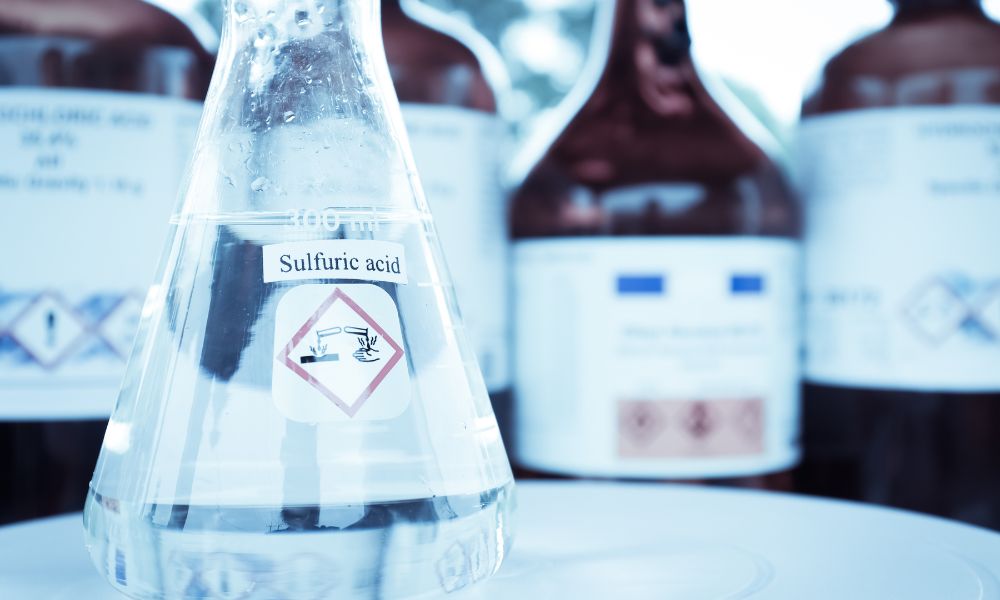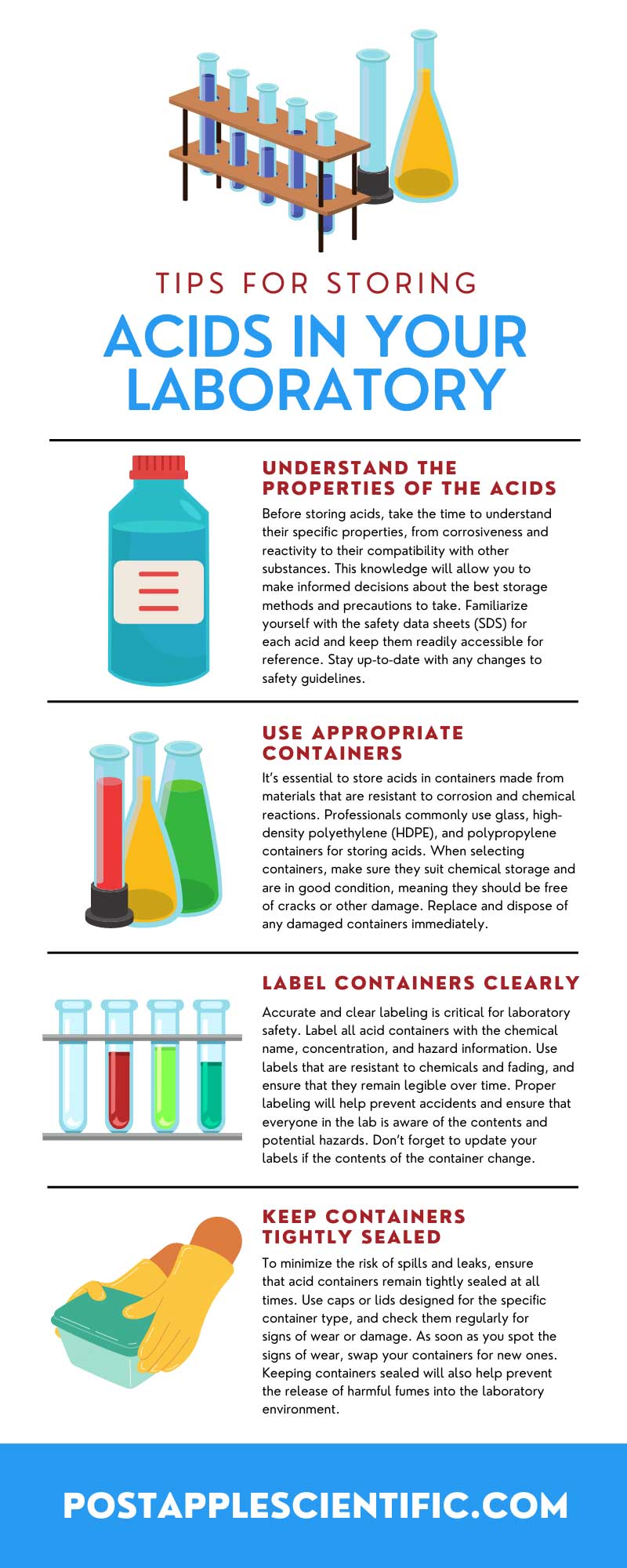Your cart is currently empty!
15 Tips for Storing Acids in Your Laboratory

Proper storage of acids in a laboratory is crucial for maintaining a safe and efficient work environment. Acids can be hazardous if not handled and stored correctly, so it’s important to follow best practices to ensure the safety of both personnel and equipment. Read on to delve into our 15 tips for storing acids in your laboratory to help you create a secure and well-organized space.
Understand the Properties of the Acids
Before storing acids, take the time to understand their specific properties, from corrosiveness and reactivity to their compatibility with other substances. This knowledge will allow you to make informed decisions about the best storage methods and precautions to take. Familiarize yourself with the safety data sheets (SDS) for each acid and keep them readily accessible for reference. Stay up-to-date with any changes to safety guidelines.
Use Appropriate Containers
It’s essential to store acids in containers made from materials that are resistant to corrosion and chemical reactions. Professionals commonly use glass, high-density polyethylene (HDPE), and polypropylene containers for storing acids. When selecting containers, make sure they suit chemical storage and are in good condition, meaning they should be free of cracks or other damage. Replace and dispose of any damaged containers immediately.
Label Containers Clearly
Accurate and clear labeling is critical for laboratory safety. Label all acid containers with the chemical name, concentration, and hazard information. Use labels that are resistant to chemicals and fading, and ensure that they remain legible over time. Proper labeling will help prevent accidents and ensure that everyone in the lab is aware of the contents and potential hazards. Don’t forget to update your labels if the contents of the container change.
Keep Containers Tightly Sealed
To minimize the risk of spills and leaks, ensure that acid containers remain tightly sealed at all times. Use caps or lids designed for the specific container type, and check them regularly for signs of wear or damage. As soon as you spot the signs of wear, swap your containers for new ones. Keeping containers sealed will also help prevent the release of harmful fumes into the laboratory environment.
Store Acids in Dedicated Cabinets
Designate specific cabinets for storing acids, and use these exclusively for this purpose. Acid storage cabinets should use corrosion-resistant materials and have features such as spill containment and ventilation to protect against leaks and fume buildup. Keep these cabinets away from heat sources and clearly label them as “Acid Storage” to avoid confusion.
Separate Acids by Compatibility
Store acids according to their compatibility to prevent dangerous reactions between incompatible chemicals. For example, separate oxidizing acids (such as nitric acid) from organic acids (such as acetic acid) and mineral acids (such as sulfuric acid solutions). Consult compatibility charts and safety data sheets to determine which acids you can store together, and regularly review compatibility information to stay informed about best practices.
Store Acids at the Appropriate Temperature
Some acids may require specific storage temperatures to maintain their stability and prevent degradation. Follow the recommendations provided in the safety data sheets, and use temperature-controlled storage cabinets when it’s necessary. Set up a system that monitors the temperature in storage areas and ensures that it stays within the recommended range.
Avoid Storing Acids Near Heat Sources
Even if you store acids at the appropriate temperature, you’ll want to keep them away from sources of significant heat. For instance, a room may be at the correct temperature according to the thermostat, but direct sunlight could raise the temperature around the acid. Heat can cause acids to degrade or become more reactive, increasing the risk of accidents.
Keep Acids at a Low Height
Store acids on lower shelves or in dedicated cabinets at a low height. This measure will reduce the risk of spills and injuries caused by falling containers and make it easier to access the acids when needed. In the event of a spill, having acids stored at a lower height also reduces the distance the liquid can spread, making cleanup easier and minimizing damage.
Store Large Volumes in Secondary Containment
For larger volumes of acids, use secondary containment to protect against spills and leaks. Secondary containment measures may include trays or basins placed under the primary containers or specialized containers with built-in spill containment. Secondary containment items should use materials compatible with the associated acids and have the capacity to hold the entire volume of the primary container in case of a leak.
As the saying goes, an ounce of prevention is worth a pound of cure—make sure you have secondary containment to prevent spills!
Regularly Inspect Containers and Storage Areas
Conduct regular inspections of acid containers and storage areas to identify any signs of damage, leaks, or other potential hazards. Check for cracks, corrosion, and compromised seals on containers, as well as any signs of spills or fume buildup in the storage area. Address any issues immediately to maintain a safe and efficient laboratory environment.
Provide Appropriate Personal Protective Equipment (PPE)
Ensure that laboratory personnel have access to the appropriate PPE, such as gloves, goggles, and lab coats, when handling or storing acids. Provide training on the proper use and maintenance of PPE to minimize the risk of accidents and injuries.
Implement Spill Response Procedures
Establish clear procedures for responding to acid spills, including how to safely contain, clean up, and dispose of the spilled material. Train all laboratory personnel on these procedures and ensure that necessary spill response supplies, such as absorbent materials and neutralizing agents, are readily available in the lab.
Limit Access to Acid Storage Areas
Restrict access to acid storage areas to authorized personnel who have received proper training in handling and storing acids. This restriction will help prevent accidents caused by inexperienced or untrained individuals and ensure that only those who understand the risks and safety procedures have access to potentially hazardous materials.
Keep an Inventory of Stored Acids
Maintain an up-to-date inventory of all acids stored in the laboratory, including information about their quantities, locations, and expiration dates. Regularly review and update the inventory to ensure that your lab disposes of outdated or unnecessary acids properly and that adequate supplies are available for ongoing laboratory needs.
Now that you know these 15 tips for storing acids in your laboratory, you can create a safe, efficient, and well-organized environment for research and experiments. Implementing best practices for acid storage will help protect both personnel and equipment and ensure the smooth operation of your lab.

Comments
One response to “15 Tips for Storing Acids in Your Laboratory”
-
[…] Ensuring the safe storage of dangerous acids is crucial to minimize the risks they pose. Store acids in compatible, tightly sealed containers in a well-ventilated, designated storage area. It’s also essential to follow safety guidelines and local regulations for the proper storage and handling of dangerous chemicals. […]
Leave a Reply